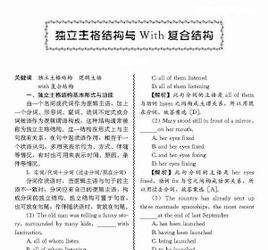本文目录
独立主格8种基本句型例句和非谓语
独立主格8种基本句型例句是:
1、名词/代词+现在分词。
2、名词/代词+过去分词。
3、名词/代词+不定式。
4、名词/代词+名词。
5.名词/代词+形容词短语。
6.名词/代词+副词。
7.名词/代词+介词短语。
8.with引导的复合结构,也可以认为是一种独立主格结构。

现在分词表示前面的名词或代词主动进行的动作或状态等。
例The man lay there, his hands trembling.
So many students being absent, the meeting had to be put off.
His homework having been done, Tom went to sleep.
注:“独立结构”中的being或having been有时可以省去,这样就成了无动词分句或过去分词分句。
独立主格结构的形式有哪些形式?
一般独立主格形式
与主句逻辑关系松散
形式为n/代词+分词 (-ing 、-ed - to do)形式; n. +不定式; n. +介词短语; n. +形容词; n. +副词;
名词/主格代词+现在分词
名词/主格代词与现在分词之间是主动关系。(表示主动和正在进行)
如:
The girl staring at him(= As the girl stared at him), he didn't know what to say. 姑娘两眼望着他,他不知道说什么好。
Time permitting(= If time permits), we will go for an outing tomorrow. 如果时间允许的话,我们明天去郊游。
名词/主格代词+过去分词(表示被动和已完成)
名词/主格代词与过去分词之间是被动关系。
如:
The problems solved(= As the problems were solved), the quality has been improved. 随着问题的解决,质量已经提高了。
Her glasses broken(= Because her glasses were broken), she couldn't see the words on the blackboard. 由于眼镜摔坏了,她看不见黑板上的字。
名词/主格代词+不定式(表示将要发生的动作)
名词/主格代词与不定式之间是主动关系,且强调的是一次具体性的动作。
如:
He is going to make a model plane,some old parts to help. 借助于一些旧零件,他要做一个飞机模型。
They said good-bye to each other,one to go home, the other to go to the bookstore. 他们道别后,一个回了家,一个去了书店。
名词/主格代词+形容词(常用来说明名词或代词的性质,特征或所处的状态)
如:
An air accident happened to the plane,nobody alive. 那架飞机遭遇了空难,无一人生还。
So many people absent, the meeting had to be called off. 这么多人缺席,会议不得不取消。
名词/主格代词+副词(常用来说明名词或代词的性质,特征或所处的状态)
如:
He put on his sweater ,wrong side out. 他把毛衣穿反了。
The meeting over, they all went home. 会议一结束,他们就都回家了。
名词/主格代词+介词短语(常用来说明名词或代词的性质,特征或所处的状态)
如:
The boy goes to the classroom,book in hand. 那男孩手里拿着书去教室。
Mary was sitting near the fire,her back towards the door.玛丽靠近火炉坐着,背对着门。
名词/主格代词+名词
His first shot failure,he fired again.
他第一枪没击中,又打了一枪。
Two hundred people died in the accident, many of them children.
两百人死于事故,其中有许多儿童。
- with 引导的独立主格:与主句逻辑关系紧密
形式为: with + n. + -ed/-ing形式; with + n. +adj.; with +n. +介词短语
with ( without)+宾语(名词/代词)+宾语补足语,宾语通常由名词或代词充当,但代词一定要用宾格。上文的独立主格结构的几种情况都适用于此结构。
The girl hid her box without anyone knowing where it was.
小女孩把盒子藏了起来,没有人知道它在哪里。(without +名词/代词+动词的-ing形式)
Without a word more spoken, she left the meeting room.
她没再说什么话就离开了会议室。(without+名词/代词+动词的-ed形式)
The kid feels excited with so many places of interest to visit.
有这么多的名胜可参观,小孩很激动。(with+名词/代词+动词不定式)
The boy was walking, with his father ahead.
父亲在前,小孩在后走着。(with+名词/代词+副词)
He stood at the door, with a computer in his hand. 或He stood at the door, computer in hand.
他站在门口,手里拿着一部电脑。(with+名词/代词+介词短语)
With his son so disappointing, the old man felt unhappy.
由于儿子如此令人失望,老人感到很不快乐。(with+名词/代词+形容词)
在with (without) 的复合结构中,多数情况下with 能省略,但without 不能省略。
- each引导的强调型独立主格
形式为:句子 +复数名词结尾 , each +介词短语/形容词短语/名词短语/-ing形式/-ed形式
这种独立主格结构为了强调句尾的复数名词
如:
Under the restructuring, the huge organization that operates the company's basic businesses will be divided into five groups,each with its own executive.(题源:《GMAT语法全解》白勇著,Page38)
-There being +名词(代词)
There being nothing else to do, we went home. 没有别的事可做,我们就回家了。
There being no further business, I declare the meeting closed. 没有再要讨论的事了,我宣布散会。
-It being +名词(代词)
It being Christmas, the government offices were closed. 由于圣诞节的缘故,政府机关都休息。
It being a holiday, all the shops were shut. 由于今天是假日,所有商店都关门了。

非谓语动词的独立主格结构在句子中的运用
说明动词的动作与其逻辑主语之间的关系。如果动作与主语是逻辑上的主动关系,那么就用V-ing;如果动作与主语是逻辑上的被动关系,那么用V-ed.
Seeing from the mountain,he found the city is beautiful.
“看”的动作,是"he"发出的,所以他们是主动关系,用V-ing
Seen from the mountain, the city is beautiful.
“看”与“城市”之间是被动关系,也就是城市被看,用V-ed

英语的独立主格结构
这句话用不定式的主动形式to look after 与独立主格结构无关,而与动词不定式作定语有关。作定语时,被修饰词是person(人)时,不定式可用主动或者用被动,意思上一般没有什么不同。换句话说:能用主动何必用被动来自寻麻烦呢?

以上就是关于独立主格结构的被动形式,独立主格8种基本句型例句和非谓语的全部内容,以及独立主格结构的被动形式 的相关内容,希望能够帮到您。
